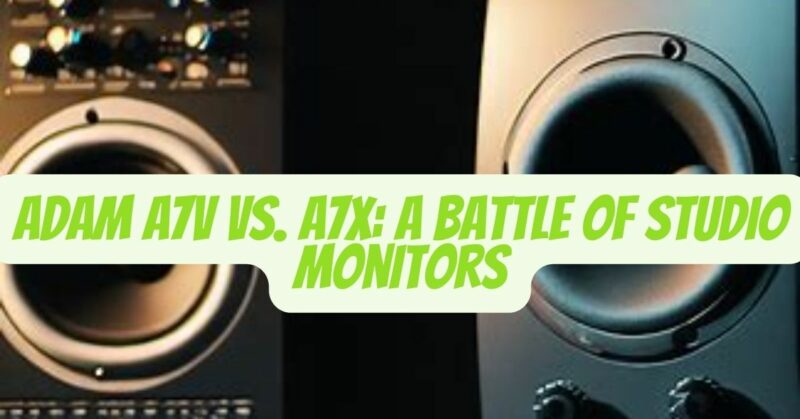Studio monitors are an essential tool for audio professionals and music enthusiasts who require accurate and precise sound reproduction. Among the numerous options available, the Adam A7V and A7X stand out as popular choices for their exceptional performance. In this article, we will compare these two models, analyzing their key features, sound characteristics, and suitability for different applications. Whether you’re a producer, engineer, or audiophile, understanding the differences between the Adam A7V and A7X can help you make an informed decision about which monitor best suits your needs.
Overview of the Adam A7V
The Adam A7V is the latest addition to Adam Audio’s renowned A-Series line of studio monitors. Designed for critical listening in recording studios, the A7V combines cutting-edge technology with years of expertise. It features a 7-inch woofer with a newly developed, ultra-linear magnet system for improved low-frequency response. The monitor is driven by a 100W Class D amplifier, providing ample power to deliver precise audio reproduction. With its extended frequency response up to 50kHz, the A7V is capable of revealing fine details in the audio spectrum, making it an ideal choice for mastering, mixing, and sound design.
Exploring the Adam A7X
The Adam A7X is a highly regarded studio monitor that has gained a strong reputation among professionals. It features a similar 7-inch woofer as the A7V, paired with an X-ART tweeter. The innovative X-ART (eXtended Accelerating Ribbon Technology) tweeter ensures a wide frequency response and exceptional transient response. With a bi-amplified design and a total power output of 150W, the A7X offers a balanced and accurate sound reproduction. The monitor’s detailed mid-range, controlled bass, and smooth highs make it a popular choice for recording, mixing, and mastering applications.
Comparing Features and Specifications
When comparing the features and specifications of the Adam A7V and A7X, several similarities and differences emerge. Both monitors incorporate Adam Audio’s proprietary technology to ensure optimal performance. However, the A7X has a higher total power output (150W) compared to the A7V (100W), giving it a slight advantage in terms of maximum volume and headroom.
The A7X also utilizes the X-ART tweeter, which offers exceptional transient response and enables extended frequency response up to 50kHz. In contrast, the A7V employs a newly developed magnet system for enhanced low-frequency reproduction. This design choice makes the A7V well-suited for applications that require a tighter and more controlled low-end response.
Sound Characteristics and Performance
Both the Adam A7V and A7X deliver remarkable sound quality, but their subtle differences influence their overall sonic signature. The A7X offers a more balanced and neutral sound, ensuring accurate representation of audio material across different genres. Its X-ART tweeter contributes to a smooth and detailed high-frequency reproduction, making it suitable for critical listening tasks.
On the other hand, the A7V exhibits a slightly warmer and more pronounced low-frequency response, which can be advantageous in certain music genres or when emphasizing bass-heavy content. While still maintaining clarity and accuracy throughout the frequency spectrum, the A7V has a character that appeals to those who prefer a more prominent low-end presence.
Application and User Preference
Choosing between the Adam A7V and A7X ultimately depends on your specific needs and personal taste. The A7X is a versatile monitor that excels in various applications, including recording, mixing, and mastering. Its balanced sound reproduction and accurate imaging make it an excellent choice for professionals who require precise monitoring capabilities. The A7X’s ability to reveal intricate details in the audio spectrum makes it particularly suitable for critical listening tasks, such as audio editing and sound design.
On the other hand, the Adam A7V’s emphasis on low-frequency response makes it a compelling option for music producers and enthusiasts who prioritize a more pronounced bass presence. Its tighter and controlled low-end reproduction can be beneficial for genres like electronic music, hip-hop, and EDM, where the bass frequencies play a significant role. The A7V’s extended frequency response up to 50kHz also allows for detailed and transparent sound reproduction, making it an excellent choice for mastering engineers who need to scrutinize every element of the mix.
It’s important to note that individual preferences and the acoustic characteristics of your listening environment can influence your decision. Factors such as room size, acoustic treatment, and personal taste in sound signature should be taken into account when choosing between the A7V and A7X.
Conclusion
In the realm of studio monitors, the Adam A7V and A7X represent two exceptional choices with their own distinct characteristics. The A7X offers a balanced and neutral sound reproduction, making it a versatile option for recording, mixing, and mastering applications. Its detailed mid-range and smooth highs ensure accurate audio representation. On the other hand, the A7V caters to those who appreciate a more pronounced low-frequency response, providing a warmer and bass-forward sonic experience.
Ultimately, the decision between the Adam A7V and A7X depends on your specific needs, musical preferences, and the nature of your projects. Both monitors excel in their respective areas, and understanding their unique features and sonic profiles will guide you in making an informed choice. Whether you prioritize accuracy and neutrality or a more pronounced low-end, Adam Audio’s A-Series monitors have you covered, ensuring high-quality sound reproduction for your professional endeavors or personal listening pleasure.


